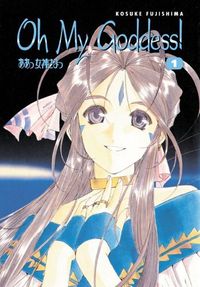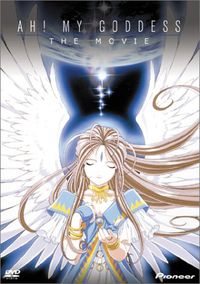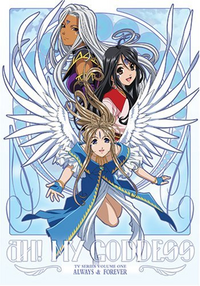Oh My Goddess!
From Wikipedia, the free encyclopedia
 |
vai alle immagini (251) di oh my goddess
Oh My Goddess! (ああっ女神さまっ, Aa! Megami-sama!),
also known as Ah! My Goddess, is a seinen manga series by Kosuke Fujishima currently serialised
in Kodansha's monthly Afternoon magazine. Originally a fairly typical magical girlfriend romantic comedy, it has grown to feature more action over time, and of recent years has put a greater focus on developing the mystical aspects of the world in which it is set. Since the manga was first published, there have been four anime offshoots
| ||||||||||||||||||||||||||||||||||||||||||||||||||
Contents [hide]
1 "Ah" versus "Oh"
2 Norse References
3 Plots
3.1 Basic story
3.2 Oh My Goddess! (Manga)
3.3 Oh My Goddess! (OVA)
3.4 The Adventures of Mini-Goddess
3.5 Ah! My Goddess The Movie
3.6 Ah! My Goddess (TV)
4 Cast and Staff
4.1 Cast
4.2 Staff
5 Soundtracks
6 Sources
7 External links
"Ah" versus "Oh"
The original Japanese title is "Aa! Megami-sama!". The question of how best to translate this phrase has led to a great deal of debate and flamewars amongst English-speaking anime fans during the early 1990s. The US-anime import company AnimEigo obtained the OVA rights and entitled them: "Oh My Goddess!". Many felt the title should be "Ah! My Goddess".
References to "Oh my god" and "Oh my goddess" in a number of songs (such as Hottokenai No Sa, Megami-sama tto Oyoubi) only fueled further debate.
Series creator Fujishima was ultimately consulted, and while his initial reaction was to agree with the "Ah" camp, once the English phrase "Oh my God" was explained to him, he decided that "Oh" would be closer to what he was trying to convey. However, when a Japanese fan later pointed out to Fujishima that the Japanese merchandise uses "Ah", Fujishima said that it would be better to keep things consistent.
Oh My Goddess! is the official English title for the manga, which is published by Dark Horse Comics; AnimeEigo later also used Oh My Goddess!. The bilingual release, which was released by Kodansha, uses Ah! My Goddess. Pioneer chose to use Ah! My Goddess in their North American release of the movie; this was possibly due not to any aesthetic considerations, but rather because AnimEigo uses the title Oh My Goddess!.
The 2005 TV series and DVD releases carry the title "Ah! My Goddess".
|
Norse References
In creating Oh My Goddess, Fujishima has borrowed extensively from Norse mythology.
The main example of this can be found in the names of the three heroines of the story--Urd, Belldandy, and Skuld. These are the names of the three Norns, the beings in charge of weaving the fate of the world. Urd, Verdandi, and Skuld, represent the past, present and future in traditional Norse, and the domains of the three goddesses match accordingly.

There has been some question throughout the duration of the series as to why Belldandy's name is not written as "Verdanthi" as it is in the original mythology. The reason for this stems from the pronunciation key of the Japanese language. First, there is no natural sound for the letter V in Japanese, and the closest that could be achieved was the B sound. Next, there is no natural sound for the "TH" combination found in European languages, and the closest to that is the D sound. Finally, "Verdanthi" would theoretically be pronounced "Verudanthi" if the other sounds existed. In order to make the sound more salient for all readers, the final change that was made to the name was to add the U to it. Put together, "Verdanthi" became "Berudandy." For ease in English pronunciation and perhaps simply for a more elegant look, the name was changed once more to "Belldandy."
The other major example of Norse reference stems from Yggdrasil, the tree that holds up the world; the Norns are said to work at the foot of this holy tree. In Oh My Goddess, the power of the goddesses is regulated by the Yggdrasil system, a physically giant, hopelessly complex computer system. The Yggdrasil system is used to access and process wish requests transferred by the Goddess Technical Helpline and the Earth Assistance Hotline, as well as to enforce the implementation of the accepted wishes.

This system is so important to the dimension inhabited by the goddesses that, when it breaks down after an attack by the Lord of Terror, the goddesses are not able to successfully fulfill their basic life functions. It is during this storyarc that readers learn that the Yggdrasil system is also used to convert energy gathered from the earth into that which the goddesses can then use to function. This particular use of Yggdrasil is meant to add dramatic color to certain storylines, and is not strictly held to throughout the rest of the series, as the system seems to be working fine most of the time.
Other examples include the periodic cameos made by Sleipnir, the heavenly steed, and Belldandy's use of Norse runes throughout the storyline. Also, it is revealed later in the series that the demons have a counterpart system to Yggdrasil--the Nidhogg system. In Norse mythology, Nidhogg is the name of the serpent that is wrapped around the base of the Yggdrasil tree, continually gnawing at its roots.
Additionally, Peorth is named after one of the runes. Peorth is the mysterious fourth goddess who is employed by a rival agency to Belldandy's. Not much is revealed about her past, except for that she and Belldandy worked together at the Yggdrasil debugging station. However, readers get the direct impression that Peorth is a fun-loving risk-taker who will stop at noting to achieve her goals. Her name makes sense, then, as the Peorth rune is classically interpreted as risk-taking and mystery. Tied to Peorth is her use of the Vanir bird to refresh Belldandy's memory. The Vanir are another set of Norse gods tied to fertility and peace--the Vanir bird's function is to reveal the past, and thus bring peace between friends.

Next, we find that Hild, the CEO of of the infernal realm, is named after one of the Valkyries, the battle spirits who take the ghostly spirits of fallen soldiers to Valhalla. According to several sources, Hild means "The Battle."
In the most recent installments of the manga, a fifth goddess is introduced into the character set. Her name is Rind, and she is a member of the Ah! My Goddess version of the Valkyries--special agents who are trained in the ways of battle. In traditional mythology, Rind is an ice giantess who becomes pregnant with Odin's child.
Finally, Skuld's second android invention is given the name Sigel by Belldandy after a storyarc revolving around the question of whether machines are alive. Sigel wants very much to be alive, and so her name is also appropriate--the Sigel rune is the rune of life.
Plots
Basic story
The manga tells the story of college freshman Keiichi Morisato, who, because of his pure heart, has been chosen by God's computer system to receive a single wish. The angel-like, "goddess" Belldandy is sent down to Earth to ask his wish, and tells him that he can potentially wish for anything he wants, from becoming a billionaire to destroying the world in an instant. However, Keiichi thinks that this entire meeting is a prank being played by his roommates, and so he wishes for Belldandy to stay with him forever, which, much to Keiichi's surprise, she does gladly. The manga follows their relationship as they become closer to each other.
The varying anime series feature the main characters and are based on the same basic plotline as the original manga, but each has taken a unique interpretation on this concept--described below--and as such should be considered separate canons. The only exception to this is the more recent TV series, which follows the plot of the manga quite closely.
Being a mechanical otaku [2] himself, Fujishima frequently bases whole chapters, or even story arcs, around mechanics, focusing especially motorcycle mechanics. Most notably, readers find that Keiichi Morisato is a member of his college's motor vehicle club, which is always under threat of being put out of commission by a rival motor club. There are also several story arcs related to racing found earlier in the manga; the concept of racing is also a significant plot device in each of the anime canons. Both Keiichi and Belldandy are exceptionally gifted at racing (Keiichi because of natural ability and Belldandy because of her ability to "talk" with the machines). Most of the other main characters have exhibited some degree of skill in racing and/or mechanics, making the idea of mechanics a significant device for character development and growth.
 Oh My Goddess! (Manga)
Oh My Goddess! (Manga)Main article: Oh My Goddess! (manga)
The manga was first published in 1988 as a spinoff of the manga You're Under Arrest (逮捕しちゃうぞ, Taiho Shichauzou). Fujishima had added a four-panel gag strip to a version You're Under Arrest in which the main characters prayed to a goddess. The gag became very popular, and Fujishima so liked the look of his drawings of the goddess that he began drawing a full-fledged manga based around her. Oh My Goddess! was published in the Japanese publisher Kodansha's monthly Afternoon magazine, where it was very warmly received--it has been a staple of Afternoon ever since. A complete collection of the manga published to date would run over 200 chapters (over thirty collected volumes). There have been twenty-two volumes of the manga published in the US so far, and publishers are now reprinting unflopped versions of the earlier graphic novels in order to spark new interest in the series.
As the manga's popularity increased, a five-episode OVA was made based on it. With the OVA's success, the stage was set for two TV series and a movie to follow. Due to its length, only the part of the plot common to the OVA and TV series as well as the manga will be included below . Sites with more lengthy and detailed synopses are listed in the External Links.
Spoiler warning: Plot and/or ending details follow.
The plot of the manga (and of most OMG series) centers on a good-natured, yet hapless and girlfriend-less college freshman named Keiichi Morisato. He is often imposed upon by his elder dorm-mates and brow-beaten into taking phone messages and doing miscellaneous chores for them. One day, while alone in his dorm, an attempt to relay a message to one of his senior dorm-mates is surprisingly redirected. To his surprise, he discovers that he has actually dialled the number of the Goddess Technical Help Line (or Goddess Relief Line, literally translated); before he can explain his error, a beautiful goddess (Belldandy, romanized to verdandi) has materialized within his room. She tells him that her agency has received a system request from him, and has sent her to grant him one wish. Understandably, Keiichi is skeptical, thinking it more plausible that his dormmates are playing some manner of practical joke on him. So he seeks to defuse the prank by asking Belldandy to stay with him forever, thinking that when the wish was refused, as it must be, he would have turned the tables on them.
The wish is granted. But Keiichi soon discovers a downside to this wish: Belldandy must live with him, but the dormitory is adamantly male-only, and so Keiichi and Belldandy are forced onto the street. As luck would have it, Keiichi's motorcycle had just been repaired, so both could ride on it. Their attempts at finding shelter at various friends' houses fail due to various reasons, so Keiichi is forced to seek shelter from a fierce storm in an old Buddhist temple. The next morning, they are greeted by a young monk who is the sole inhabitant of the temple. He welcomes them and allows them to stay for a little while until they can find lodging; he then immediately puts them to work maintaining the temple grounds. When Belldandy uses her powers to save Keiichi, the priest begins to fear that Belldandy is no ordinary girl, rather a foreign demon or sorceress of some sort. He investigates, and is eventually persuaded of Belldandy's intrinsic goodness when he witnesses her solicitous care of the temple premises and her perfect meditation ritual; he decides to go on a pilgrimage to India, granting the two lovers permission to remain in the temple contingent upon its good maintenance. Due to luck, or perhaps divine intervention, the two now have a home.
Oh My Goddess! (OVA)
Main article: Oh My Goddess! (OVA)
A five episode OVA series titled Oh My Goddess! (ああっ女神さまっ, Aa! Megami-sama!) featuring Keiichi, Belldandy, and the other major characters from the manga was produced in 1991 by AIC and was distributed in the US by AnimEigo [3]. The OVA is based on several early plots from the manga, but with many events and characterizations removed. The other Goddesses, Urd and Skuld, are introduced comparatively early (in the second and third episodes, respectively), and in the final two episodes, The Almighty begins working to separate the two, forcing Belldandy to return to Heaven and her duties.
AnimEigo has also talked about a late spring/early summer release in 2006 for their re-release of the Oh My Goddess! OVA series as well in recent emails to fans. [4]
The Adventures of Mini-Goddess
Main article: The Adventures of Mini-Goddess
A 48 episode TV series Adventures of Mini-Goddess (ああっ女神さまっ 小っちゃいって事は便利だねっ, Aa! Megami-sama! Chicchaitte Koto wa Benri da ne ) series featuring shrunken versions of Urd, Belldandy, and Skuld in a comedic super deformed style was produced in 1998. It was a part of the omnibus show Anime Complex on WOWOW and was distributed in the US by Geneon Entertainment [5]. This series departs the most from the basic manga storyline, and indeed, shares next to no continuity with the previous series.
Ah! My Goddess The Movie
Main article: Ah! My Goddess The Movie
In 2000, the Ah! My Goddess: The Movie (劇場版ああっ女神さまっ, Gekijouban Aa! Megami-sama) was produced by AIC, seeing the return of the main cast, along with several popular characters from the manga who had not appeared in any of the previous anime. It was distributed in the US by Geneon Entertainment in 2001 [6]. The plot does not seem to follow any of the existing canon, but uses plot devices from several different story arcs from the manga.
Ah! My Goddess (TV)
Main article: Ah! My Goddess (TV)
Main article: List of Oh My Goddess episodes
In 2005, a new anime TV series of Ah! My Goddess! (ああっ女神さまっ, Aa! Megami-sama!) began airing in Japan, again produced by AIC and distributed in the US by Media Blasters [7]. In this version, they have returned to the manga roots of the series, retelling events much closer to their original form. Though there are minor differences, typically based on what is considered unacceptable for television, this version follows the canon of the manga quite closely. Although only 24 episodes were aired, the Japanese DVD releases will have 2 bonus episodes focusing on the aftermath of the season finalé.
A second season titled Ah! My Goddess: Everyone Has Wings (Japanese: ああっ女神さまっ それぞれの翼 - Aa! Megami-sama: Sorezore no Tsubasa) is in progress as of April 6, 2006 picking up the story from where the series left in season one.
| |||||||||||||||||||||||||||
| |||||||||||||||||||||||||||
| |||||||||||||||||||||||||||





